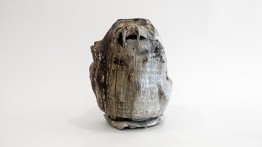Adam Silverman | Eight Tide Jars
Thu, Sep 5, 2pm - Sun, Sep 29, 2019 7pm

Courtesy of Friedman Benda and Adam Silverman
THIS EXHIBITION HAS BEEN EXTENDED THROUGH SUNDAY, SEPTEMBER 29
This site-specific installation, located in the 7th floor lobby gallery, highlights Adam Silverman’s unique and personal work, which is influenced by his architectural training and his interest in process.
Opening Reception: Thursday, September 5, 7 - 9pm
Each of the eight wheel-thrown pieces on display began as a 25 pound extruded brick of industrially processed clay. They were each placed directly on the wheel head (rather than starting with a ball of clay, as is the norm). The top – and the majority – of the clay was then pounded into a ball and thrown from there, leaving a clear, integral square foot for the finished piece to stand on. Each piece typically spends at least a week on the wheel as it is slowly worked from a brick to a ball to a cylinder to an egg to a punched and pounded shadow of its original shape.
“Tide Jar” is a term that Silverman sometimes uses to describe this body of work. “Jar,” as a typology, refers specifically and especially to the Korean Moon Jar. Originally unique to Korea, moon jars were made from the mid-17th to mid-18th centuries and were used for storing rice, soy sauce, alcohol, and sometimes displaying flowers. “Moon” refers to the exterior color and shape of the vessel. “Jar” refers to the interior and original function of storage. Together the two words describe a humble functional object that has become a revered formal and historical icon.
“Tide” as used here refers to the rise and fall of the sea as caused by the effects of the gravitational forces exerted by the moon. More specifically, it is the resulting forces of the tides as experienced in the waves and currents; these are irregular forces, motion, and energies that vary from gentle to rolling to violent. These jars are subjected to similar types forces, both by me and by the kilns.
These Tide Jars are of the earth and the oceans. They are made with natural materials: clays, wood ash, seaweed, corn husks, sea shells, beach dune clay, ocean salt, pine needles, iron oxide, manganese oxide, and cobalt oxide. These materials are used to make the jars, mixed into glazes or introduced into the kilns during the firing process. The pieces are fired, usually several times, to at least 2,400 degrees Fahrenheit in kilns that are extreme in atmosphere and temperature. Some have no glazes applied other than what is created naturally by the kiln’s extreme environment.
Adam Silverman was born in 1963 in New York, NY and received a BFA and a Bachelors of Architecture from the Rhode Island School of Design in 1987 and 1988. Silverman’s work is included in the permanent collections of the Israel Museum, Jerusalem, Israel; Los Angeles County Museum of Art, Los Angeles, CA; the Museum of Contemporary Craft, Portland, OR; the Nasher Sculpture Center, Dallas, TX; Palm Springs Art Museum, Palm Springs, CA; Rhode Island School of Design Museum, Providence, RI; and Yale University Art Gallery, New Haven, CT.
7th floor Lobby Gallery
Gallery Hours
Tuesday – Friday 2pm-7pm, Saturday and Sunday 12pm-7pm
View the full Fall 2019 Lectures and Events List.
Located at 7 East 7th Street, between Third and Fourth Avenues




